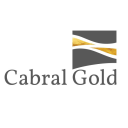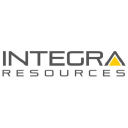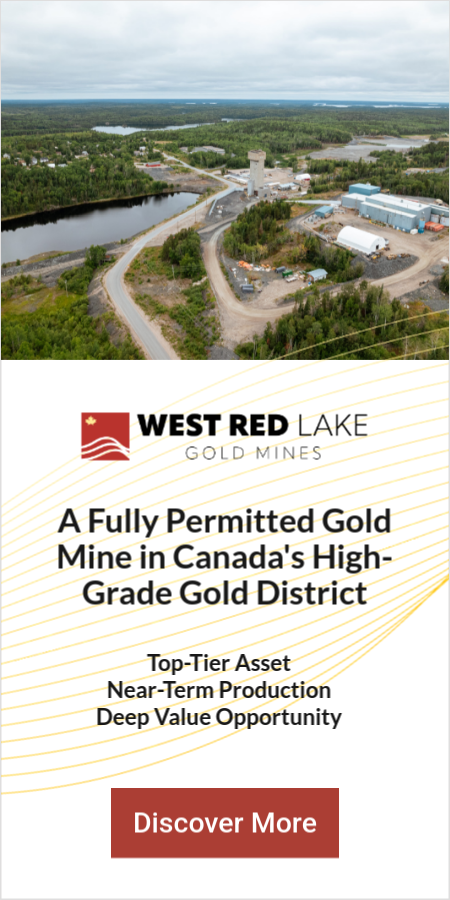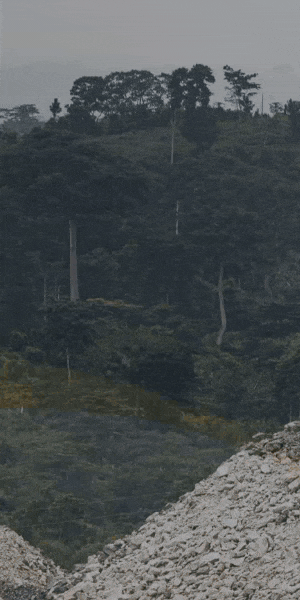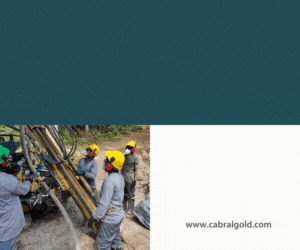Fed Rate Cuts & Gold's Structural Repricing: Why Lower Real Yields Favor High-Margin Producers & De-Risked Developers

Federal Reserve easing and lower real yields are driving gold's shift from tactical hedge to strategic allocation, creating value across producers and developers.
- The Federal Reserve's anticipated easing cycle is supportive for non-yielding assets like gold as real interest rates compress, with the forward curve reflecting market recognition of accumulating downside risks including slowing labour markets and elevated corporate refinancing pressures.
- Gold trading above recent highs reflects structural support from central bank buying exceeding 1,000 tonnes annually since 2022, de-dollarization trends, and renewed Western investor inflows, reinforcing the metal's shift from cyclical hedge to strategic portfolio allocation.
- High-quality gold producers such as Perseus Mining, Serabi Gold, West Red Lake Gold Mines, and i-80 Gold offer substantial margin expansion potential, with all-in sustaining costs well below recent spot prices and balance sheets positioned for disciplined growth.
- De-risked developers including Integra Resources, New Found Gold, U.S. Gold Corp, and Cabral Gold provide leveraged exposure, with robust internal rates of return and net present values highly sensitive to sustained higher gold prices.
- For investors, the combination of Federal Reserve easing expectations, structurally supportive real-rate dynamics, and high-margin company case studies argues for a strategic, rather than tactical, allocation to gold equities within diversified portfolios.
Fed Easing Expectations & the Repricing of Real Rates
The Federal Reserve's anticipated policy normalization marks a transition from a higher-for-longer narrative towards gradual easing. The significance extends beyond headline rate moves, what matters for gold pricing is the evolution of real rates, defined as nominal yields adjusted for inflation expectations.
Real interest rates represent the true opportunity cost of holding non-yielding assets. When real rates fall, gold's relative attractiveness increases as investors face diminishing returns from traditional fixed-income alternatives. The anticipated Federal Reserve easing cycle creates a bridge between policy expectations and asset allocation decisions. For gold, this dynamic is particularly consequential given its dual role as both portfolio diversifier and monetary alternative.
Futures Pricing & Policy Signalling
Federal Reserve funds futures reflect market recognition of accumulating downside risks, slowing labour markets, moderating credit growth, and elevated corporate refinancing pressures. The signalling effect matters more than mechanical rate adjustments: it establishes that the real-rate peak may be behind us. For long-duration assets such as gold mines with decades of reserve life, even modest changes in expected policy paths can drive disproportionate repricing.
Why Real Yields Drive Gold

Real yields, commonly proxied by Treasury Inflation-Protected Securities yields, have exhibited a strong inverse correlation with gold prices. Lower real yields reduce the opportunity cost of holding gold, making it a more attractive portfolio allocation. With central banks adding over 1,000 tonnes per year, Federal Reserve easing reinforces an already strong structural bid. The combination of official sector demand, de-dollarization trends, and returning Western investor flows has created a price floor that is higher and more resilient than in prior cycles.
From Cyclical Hedge to Strategic Allocation
Gold has moved beyond its traditional role as a short-term hedge into a strategic allocation in diversified portfolios. This shift reflects a fundamental recalibration driven by central bank policy, geopolitical fragmentation, and renewed institutional interest. The combination of persistent central bank accumulation, accelerating de-dollarization, and Western investor re-engagement has established a structural floor under the market, reinforced by supply constraints.
Central Bank Accumulation & De-Dollarization
Central banks have purchased over 1,000 tonnes of gold annually since 2022, well above the prior decade's average. This sustained official sector demand reflects a strategic shift in reserve management: diversifying away from United States dollar-denominated assets, managing sanctions risk, and seeking a neutral store of value in an increasingly multipolar monetary system. When official sector demand absorbs supply at scale, price discovery shifts upward, creating a higher equilibrium level for gold.
The importance of a stable, elevated gold price environment extends to mining companies with long-life underground projects, where economic viability depends on sustained price levels rather than short-term spikes. i-80 Gold's production pathway targets approximately 200,000 ounces annually as an intermediate milestone, with production scaling toward approximately 600,000 ounces in the early 2030s. Richard Young, Chief Executive Officer of i-80 Gold, emphasizes the company's positioning:
"By 2028 we expect to produce about 200,000 ounces per year and generate EBITDA somewhere between $200 and $300 million depending on the price of gold."
Western Investor Re-Engagement
Western exchange-traded fund flows have returned to positive territory in 2025 following years of sustained outflows. The Federal Reserve's anticipated easing cycle has renewed appetite for gold as both portfolio diversifier and inflation hedge. A 5 to 10% allocation to bullion and gold equities can improve risk-adjusted returns due to low correlation with traditional assets.
The return of sustained investor interest has tangible effects on liquidity, capital access, and merger and acquisition appetite for established producers. Perseus Mining's strong balance sheet and cash generation provide significant operational flexibility in the current market environment. Craig Jones, Managing Director and Chief Executive Officer of Perseus Mining, emphasizes the company's financial strength:
"We can pay for all of our aspirations within our current cash flows."
This reflects the position of well-capitalized producers in an environment where gold prices support organic growth without requiring external financing or dilutive equity raises.
Translating Macro Tailwinds into Mine Economics
At elevated gold prices and industry all-in sustaining cost averages of approximately $1,600 per ounce, producers are generating robust margins, while developers are seeing material uplifts in project internal rates of return and net present values. Core valuation metrics include all-in sustaining costs, net present value sensitivity to price assumptions, internal rate of return thresholds, and enterprise value per ounce benchmarks.
Disciplined capital allocation becomes the differentiating factor in this environment. Serabi Gold's strategy focuses on organic, low-capital intensity expansion that can be funded internally. Mike Hodgson, Chief Executive Officer of Serabi Gold, highlights the strategic approach advantage:
"We can fund all of that to cash flow. We can fund the plant growth out of cash flow when we come to do it."
Producers Best Placed to Monetise a Lower-Real-Rate Gold Environment
Companies generating meaningful production can quickly translate macro tailwinds into earnings before interest, taxes, depreciation, and amortization, free cash flow, and higher net asset value. Perseus Mining, Serabi Gold, West Red Lake Gold Mines, and i-80 Gold represent this spectrum across established multi-mine producer, high-grade Brazilian operation, recently restarted Red Lake mine, and emerging Nevada platform.
Margin Expansion: Perseus Mining & Serabi Gold
Perseus Mining reported net cash and bullion of $837 million as of September 2025, maintaining a zero-debt position with a $300 million undrawn credit facility. During the September 2025 quarter, the company produced approximately 100,000 ounces at an all-in site cost of $1,463 per ounce. The spread between these costs and elevated gold prices translates into substantial unit margins supporting resilient free cash flow.
Serabi Gold operates high-grade underground assets in Brazil's Tapajós region, targeting stable production growing to 60,000 ounces by 2026, with 2025 guidance of 44,000 to 47,000 ounces. As fixed costs are spread over higher throughput, reverse torque on all-in sustaining costs amplifies gold-price leverage. The company benefits from favourable Brazilian exchange rate dynamics, which lower effective costs in United States dollar terms.
Production Growth: West Red Lake Gold Mines & i-80 Gold
West Red Lake Gold Mines has restarted production at the Madsen mine in Ontario's Red Lake district and is ramping toward operational stability, targeting 67,600 ounces annually over six full production years. The operation is generating positive cash flow during ramp-up. A combined Madsen-Rowan prefeasibility study is targeted for third quarter 2026, with the combined operation targeting production exceeding 100,000 ounces per year by 2029.
i-80 Gold is producing in Nevada while advancing a development plan targeting approximately 600,000 ounces in annual gold output by the early 2030s. The company holds the fourth-largest resource base in Nevada, with consolidated measured and indicated resources of 14 million ounces gold and 195.8 million ounces silver at Mineral Point. The company owns the Lone Tree autoclave, which lifts recoveries to approximately 92%. A refurbishment study is expected in fourth quarter 2025, with the company targeting $350 million to $400 million in senior debt financing by mid-2026.
Developers Converting Optionality into Cash Flow
Developers sit at the optimal point for valuation torque when gold prices move higher and real rates ease. These companies often have completed feasibility work, defined resources, and clear permitting roadmaps, but have not yet fully priced in the cash flow profile implied by elevated gold prices.
IRR & NPV Uplift: Integra Resources, New Found Gold & U.S. Gold Corp
Integra Resources operates Florida Canyon, producing 70,000 to 75,000 ounces in 2025, providing cash flow to support platform development. The company holds consolidated measured and indicated resources of 13.4 million ounces gold-equivalent across Florida Canyon, DeLamar, and Nevada North. DeLamar's mine plan of operations was deemed complete by the Bureau of Land Management in third quarter 2025, with a feasibility study expected in fourth quarter 2025.
New Found Gold's Hammerdown feasibility study targets 50,000 ounces per year at all-in sustaining costs of $912 per ounce, with production targeted for 2026. The company owns fully permitted infrastructure at Pine Cove Mill. Queensway's preliminary economic assessment shows life-of-mine all-in sustaining costs of $1,256 per ounce with Phase 1 production targeted for 2027. Keith Boyle, Chief Executive Officer of New Found Gold, frames the financing strategy:
"We saw the cash flow from Hammerdown as a piece of the financing for our Queensway phase one."
U.S. Gold Corp's CK Gold project in Wyoming received its mine operating permit in April 2024. Being fully permitted in a Tier-1 United States jurisdiction provides strong advantage as capital flows toward projects with regulatory clarity and near-term construction visibility. The timing of permit approvals has aligned favourably with renewed market interest in the sector.
District-Scale Optionality: Cabral Gold
Cabral Gold 's Cuiú Cuiú oxide starter project demonstrates exceptional economics at elevated gold prices. The July 2025 prefeasibility study shows an after-tax internal rate of return of 78% and net present value at 5% discount of $74 million at $2,500 per ounce, with life-of-mine all-in sustaining costs of $1,210 per ounce and initial capital expenditure of $37.7 million. The project is under construction as a fully funded starter operation, with production of approximately 18,500 ounces annually targeted from fourth quarter 2026. The strategic value lies in using Stage 1 cash flow to fund district-scale drilling, potentially avoiding dilutive equity raises.
The Investment Thesis for Gold
- Federal Reserve easing expectations and lower real rates are reinforcing a structural bid for gold already supported by central bank buying and de-dollarization.
- • Structural real-rate compression reduces the opportunity cost of holding gold, with anticipated Federal Reserve policy normalization creating a favourable environment for long-duration mining assets with decades of reserve life.
- • Balance-sheet-backed producers like Perseus Mining and Serabi Gold demonstrate how low all-in sustaining costs and conservative leverage convert macro tailwinds directly into free cash flow without reliance on external financing.
- • Production growth stories including West Red Lake Gold Mines and i-80 Gold offer operational leverage through scaling output, with existing infrastructure and resource bases supporting expansion at favourable margins.
- • De-risked development pipelines including Integra Resources, New Found Gold, U.S. Gold Corp, and Cabral Gold offer high-internal-rate-of-return projects whose net present values are materially enhanced at higher price decks.
- • Jurisdictional resilience across Nevada and Wyoming, Ontario's Red Lake district, the Great Basin, and Brazil's Tapajós region mitigates sovereign risk and supports valuation multiples.
- • Portfolio diversification through a 5 to 10% allocation to bullion and high-quality gold equities can improve risk-adjusted returns and hedge against policy error, currency volatility, and geopolitical shocks.
Fed Easing, Real Rates & Gold's Evolving Role
The anticipated Federal Reserve policy normalization is significant as confirmation that the real-rate cycle may be shifting in favour of gold. This transition is reinforced by structural drivers including central bank accumulation above 1,000 tonnes annually, accelerating de-dollarization, and renewed Western investor interest as exchange-traded fund flows turn positive.
The companies profiled illustrate the spectrum of ways to express the gold thesis. Established producers like Perseus Mining and Serabi Gold offer immediate margin expansion. Companies scaling production such as West Red Lake Gold Mines and i-80 Gold provide operational leverage. Late-stage developers including Integra Resources, New Found Gold, U.S. Gold Corp, and Cabral Gold deliver leveraged exposure through robust project economics.
For institutional and sophisticated retail investors, the combination of Federal Reserve easing expectations, structural gold demand, and well-positioned companies argues for treating gold as a strategic allocation within diversified portfolios. The investment case rests on fundamental shifts in monetary policy, reserve management, and portfolio construction. Companies with disciplined capital allocation, competitive cost structures, and clear development pathways are positioned to translate this multi-year macro tailwind into shareholder value.
TL;DR
The Federal Reserve's anticipated policy normalization is compressing real interest rates, making gold more attractive as the opportunity cost of holding non-yielding assets declines. Central bank purchases exceeding 1,000 tonnes annually since 2022, combined with de-dollarization trends and renewed Western investor interest, have established a structural floor under gold prices. Producers like Perseus Mining, Serabi Gold, West Red Lake Gold Mines, and i-80 Gold offer immediate margin expansion with all-in sustaining costs well below current prices. Developers including Integra Resources, New Found Gold, U.S. Gold Corp, and Cabral Gold provide leveraged exposure through high-IRR projects whose valuations are highly sensitive to sustained higher gold prices. Investors should consider gold equities as a strategic portfolio allocation rather than a tactical trade.
FAQs (AI-Generated)
Analyst's Notes




Subscribe to Our Channel
Stay Informed










